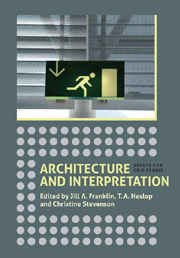Book contents
- Frontmatter
- Contents
- List of Illustrations
- Preface: In Appreciation
- List of contributors
- 1 Introduction
- Incitements to Interpret in Late Antique and Medieval Architecture
- Authors and Intentions
- Architecture beyond Building
- 266 Innovation and Traditionalism in Writings on English Romanesque
- 284 Why Medieval Ireland Failed to Edify
- 306 The Chapel of the Hospital of Saint-Jean at Angers: Acta, Statutes, Architecture and Interpretation
- 315 Sealed Architecture: City Seals, Architecture and Urban Identity in the Northern Netherlands, 1200–1700
- 333 Style and Geography: Struggles for Identification in the Later Nineteenth Century
- 343 The Dome of the Rock: From Medieval Symbol to Modern Propaganda
- 357 Towards a Cultural Geography of Modern Memorials
- 381 Bicycle Sheds Revisited, Or: Why are Houses Interesting?
- Index
357 - Towards a Cultural Geography of Modern Memorials
from Architecture beyond Building
Published online by Cambridge University Press: 05 April 2013
- Frontmatter
- Contents
- List of Illustrations
- Preface: In Appreciation
- List of contributors
- 1 Introduction
- Incitements to Interpret in Late Antique and Medieval Architecture
- Authors and Intentions
- Architecture beyond Building
- 266 Innovation and Traditionalism in Writings on English Romanesque
- 284 Why Medieval Ireland Failed to Edify
- 306 The Chapel of the Hospital of Saint-Jean at Angers: Acta, Statutes, Architecture and Interpretation
- 315 Sealed Architecture: City Seals, Architecture and Urban Identity in the Northern Netherlands, 1200–1700
- 333 Style and Geography: Struggles for Identification in the Later Nineteenth Century
- 343 The Dome of the Rock: From Medieval Symbol to Modern Propaganda
- 357 Towards a Cultural Geography of Modern Memorials
- 381 Bicycle Sheds Revisited, Or: Why are Houses Interesting?
- Index
Summary
IT IS VIRTUALLY IMPOSSIBLE to move through a European or American city without passing memorials that prompt us – if we notice them at all – merely to scratch at some fading memory. Instead of recalling civic or national heroes, important events, or victories in battle, we see the erosions of time, the way they make way for the daily pulses of urban movement, or how commerce corrals them into corners where they can grow old invisibly. Even the most familiar memorials, ones that we use repeatedly or ritualistically to cultivate a sense of collective recall, constantly confront obsolescence and alienation. Who are these strangers and how did they get that way? How, moreover, are we to understand them in their ever-changing states?
Memorials and cities have a conflicted relationship, the latter often sacrificing the former to its changing speed, scale, material reality, or, just as importantly, modern disregard. This disregard has taken the shape of movements against traditional memorials, even against the project of memorialization itself. At other times it has overflowed into outright disgust, ending in acts of iconoclasm or wilful destruction. Most often, it takes the form of neglect, arguably the most damning dismissal of all because it entails forgetting – the precise thing memorials are supposed to ward against. Neglect, however, is difficult to study, and even harder to historicize. Beyond the mere process of forgetting, which one can find in literal deterioration, as when nostalgic patina turns into irreversible destruction, neglect is also quite literally a passing matter.
- Type
- Chapter
- Information
- Architecture and InterpretationEssays for Eric Fernie, pp. 357 - 380Publisher: Boydell & BrewerPrint publication year: 2012



